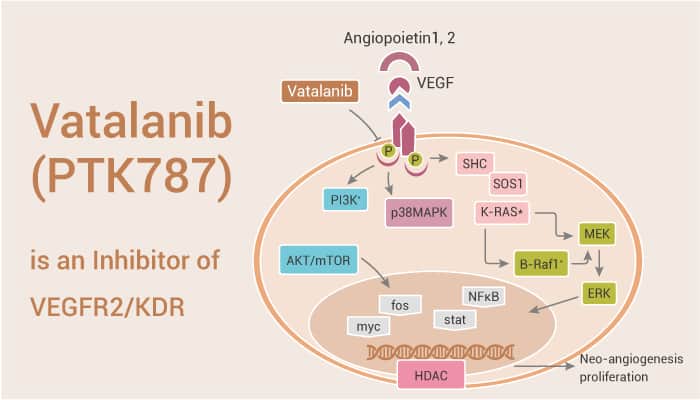Vascular endothelial growth factor receptor (VEGFR) is the receptor for VEGF. VEGF is an important signaling protein involved in both vasculogenesis and angiogenesis. VEGFRs consist of three subtypes, the fms-like tyrosine kinase Flt-1 (VEGFR1/Flt-1), the kinase domain region, also referred to as fetal liver kinase (VEGFR2/KDR/Flk-1), and Flt-4 (VEGFR3). VEGFR1 and 2 exist in vascular endothelial cells, whereas VEGFR3 exists in lymphatic endothelial. Binding of VEGF to VEGFR causes dimerization and autophosphorylation of the receptor. Several signal transduction pathways are activated by the binding of VEGF to its receptor, leading to increased proliferation, survival, permeability, and migration of cells.
VEGFR2 (KDR, Flk-1, CD309), is a type V receptor tyrosine kinase. Numerous studies have reported VEGFR2 expression in carcinoma cells, especially in mammary, colorectal, lung non-small cell, and urothelial, carcinomas. This receptor responds to the signal of VEGF binding, which initiates a phosphorylation cascade that ultimately involves nuclear regulatory targets resulting in enhancement of endothelial proliferation and migration. Angiogenesis inhibition by blocking the VEGFR2 is an emerging strategy to develop selective and specific anticancer agents.
Vatalanib is a VEGFR2 inhibitor.
 Vatalanib is a small molecule protein kinase inhibitor that inhibits angiogenesis. It inhibits all known VEGFR, as well as platelet-derived growth factor receptor-beta and c-kit, but is most selective for VEGFR2. Vatalanib shows the anti-proliferation effect by inhibiting thymidine incorporation induced by VEGF in HUVECs. And it dose-dependently suppresses VEGF-induced survival and migration of endothelial cells. A recent study shows that Vatalanib significantly inhibits the growth of hepatocellular carcinoma cells. And it enhances the IFN/5-FU induced apoptosis by increasing proteins levels of Bax and reduced Bcl-xL and Bcl-2. What’s more, Vatalanib induces inhibition of the angiogenic response to VEGF and PDGF in both a growth factor implant model and a tumor cell-driven angiogenesis model.
Vatalanib is a small molecule protein kinase inhibitor that inhibits angiogenesis. It inhibits all known VEGFR, as well as platelet-derived growth factor receptor-beta and c-kit, but is most selective for VEGFR2. Vatalanib shows the anti-proliferation effect by inhibiting thymidine incorporation induced by VEGF in HUVECs. And it dose-dependently suppresses VEGF-induced survival and migration of endothelial cells. A recent study shows that Vatalanib significantly inhibits the growth of hepatocellular carcinoma cells. And it enhances the IFN/5-FU induced apoptosis by increasing proteins levels of Bax and reduced Bcl-xL and Bcl-2. What’s more, Vatalanib induces inhibition of the angiogenic response to VEGF and PDGF in both a growth factor implant model and a tumor cell-driven angiogenesis model.
All in all, Vatalanib, an inhibitor of VEGFR2/KDR, exhibits anti-tumor activity.
Reference:
Wang X, et, al. Front Cell Dev Biol. 2020 Nov 16;8:599281.